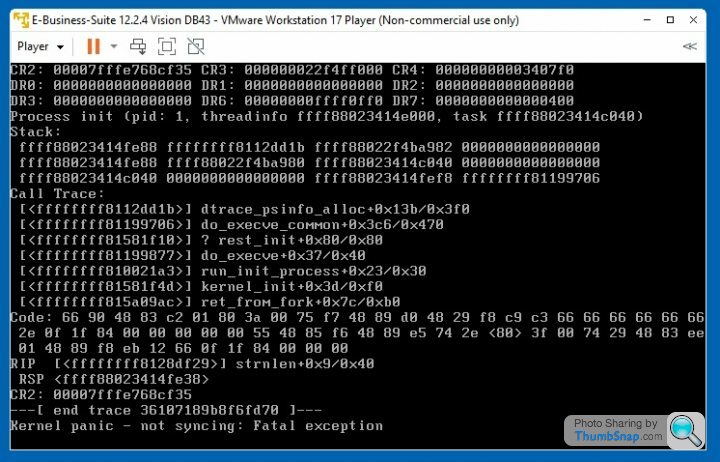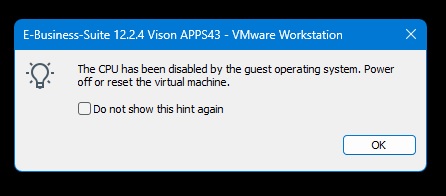Moving VMware VM to a new machine, fails to boot
Discussion
I have recently taken delivery of a new Scan 3XS system, the intention being in part to host my existing Oracle EBS VMs and drastically increase the available horsepower.
Current machine is a simple Thinkserver TS140, Win 7 Ultimate 64 bit.
New machine is running Win 11 Professional for Workstations.
Initially I installed VMware Player 7.1.0 as used on the Win 7 machine, copied the VM to the new machine, used the 'I copied it' option ( a method I have used numerous times when upgrading the current machine). And watched it sit for ages until 'Kernel panic - not syncing : Fatal exception'.
I then uninstalled Player 7 and downloaded and installed VMware Workstation 17.0.1 Player.
The results were the same, as below screen shot.
Any suggestions gratefully accepted.

Current machine is a simple Thinkserver TS140, Win 7 Ultimate 64 bit.
New machine is running Win 11 Professional for Workstations.
Initially I installed VMware Player 7.1.0 as used on the Win 7 machine, copied the VM to the new machine, used the 'I copied it' option ( a method I have used numerous times when upgrading the current machine). And watched it sit for ages until 'Kernel panic - not syncing : Fatal exception'.
I then uninstalled Player 7 and downloaded and installed VMware Workstation 17.0.1 Player.
The results were the same, as below screen shot.
Any suggestions gratefully accepted.

Edited by Goaty Bill 2 on Sunday 9th April 09:24
According to Google, setting the VM to 2 CPUs (not core) seems to resolve a few of these. Have you tried that?
https://forums.oracle.com/ords/apexds/post/kernel-...
Also, have you made sure to disable Hyper-V on the new OS?
https://forums.oracle.com/ords/apexds/post/kernel-...
Also, have you made sure to disable Hyper-V on the new OS?
xeny said:
Can you build a trivial VM, to isolate if the problem is with the host or this particular guest?
An excellent suggestion. And yes that has worked. Installed a Win7 Professional and Oracle Linux 9.I downloaded VMware Workstation Pro and I am now going through the process of 'upgrading' the VM by stages to the latest version.
A 'simple upgrade allowed the VM to start, but I would dearly love to take some advantage of the dual Xeons x 18 core processors.
So far it has only allowed 2 CPUs with 1 core each.
Thanks to all for the suggestions.
I will update with success or further issues in due course.
If you're after that kind of performance, surely you'd be better served by something like VSphere or Hyper-v ?
Especially as core counts go higher, my understanding is that getting great performance out of virtualization tools like Workstation/Player or for that matter Virtual Box becomes trickier as they have to present each guest CPU to the host OS as an individual thread, and keeping them synchronised starts becoming a significant overhead.
Especially as core counts go higher, my understanding is that getting great performance out of virtualization tools like Workstation/Player or for that matter Virtual Box becomes trickier as they have to present each guest CPU to the host OS as an individual thread, and keeping them synchronised starts becoming a significant overhead.
xeny said:
If you're after that kind of performance, surely you'd be better served by something like VSphere or Hyper-v ?
Especially as core counts go higher, my understanding is that getting great performance out of virtualization tools like Workstation/Player or for that matter Virtual Box becomes trickier as they have to present each guest CPU to the host OS as an individual thread, and keeping them synchronised starts becoming a significant overhead.
Especially as core counts go higher, my understanding is that getting great performance out of virtualization tools like Workstation/Player or for that matter Virtual Box becomes trickier as they have to present each guest CPU to the host OS as an individual thread, and keeping them synchronised starts becoming a significant overhead.
eeLee said:
indeed I would be importing these VMs into a server rather than hosting them in a workstation environment. I used Hyper-V 2019 for this on several machines at home and I prepare the VMs I want to use on Win11Pro and export them to Hyper-V for installation.....
Well, that put me in my place 
It seems I have been looking for champagne performance on a premium beer budget. Greed is a terrible thing.
Unfortunately I don't wish to dedicate quite that level of financial resourcing to this. The machine will have to perform dual duties as a graphics workstation and part time Oracle EBS server; dependent on current assignment. So VMware Workstation would seem to be the practical limit.
Through a step by step process of upgrade by cloning, I have manage to get the database and middle tier application server VMs running with 2 CPUs x 8 cores and 32 GB memory each.
I think I will concentrate on getting the network settings sorted out and do my best to feel satisfied with what I have.
Many thanks to all that replied.
Realising OP has already sorted it and clearly knows a lot more about VMs than me, but as a complete VM noob I recently set up an Ubuntu environment in Hyper-V on Win11 Pro and found it a piece o'piss. I even used a proper ISO instead of the "quick set up" option.
I'm sure there's reasons that Hyper-V isn't suited to power-use but for my uses (some Linux-only analysis tools that I want to run natively rather than wrapping for windows, with a VPN onto a particular network to pull data from that I didn't want all my net traffic going through) it works really well. I had to use Power Shell to set the screen resolution to something more appropriate but that was an easy Google. Again, noob here.
I'm sure there's reasons that Hyper-V isn't suited to power-use but for my uses (some Linux-only analysis tools that I want to run natively rather than wrapping for windows, with a VPN onto a particular network to pull data from that I didn't want all my net traffic going through) it works really well. I had to use Power Shell to set the screen resolution to something more appropriate but that was an easy Google. Again, noob here.
Gassing Station | Computers, Gadgets & Stuff | Top of Page | What's New | My Stuff




